Schizoaffective Disorder Case Study
VerifiedAdded on 2023/01/19
|12
|3126
|29
AI Summary
This case study explores the symptoms, pathophysiology, and nursing management of Schizoaffective Disorder. It discusses the importance of proper medication adherence, psychotherapy, and patient education in managing the disorder and improving the quality of life for patients.
Contribute Materials
Your contribution can guide someone’s learning journey. Share your
documents today.
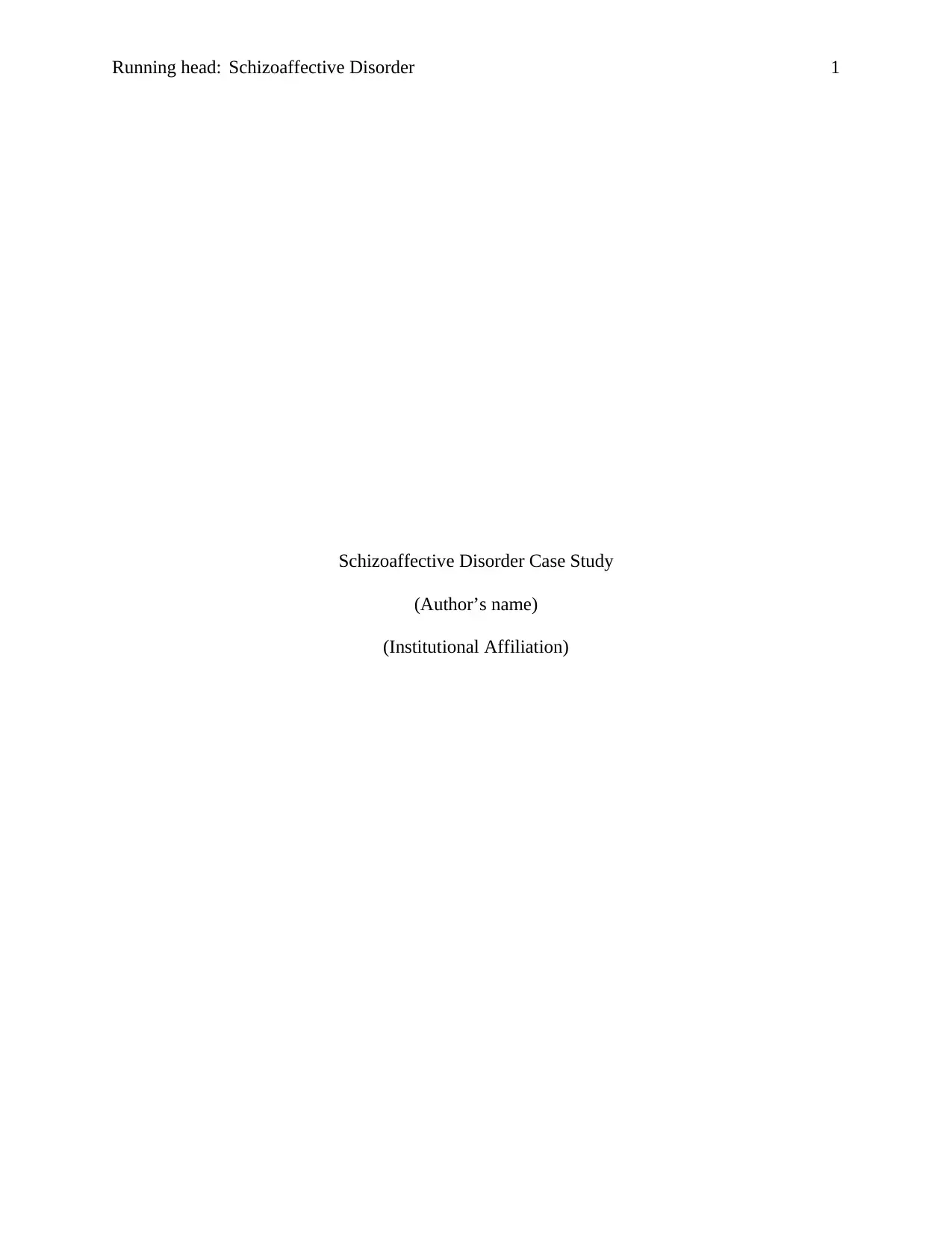
Running head: Schizoaffective Disorder 1
Schizoaffective Disorder Case Study
(Author’s name)
(Institutional Affiliation)
Schizoaffective Disorder Case Study
(Author’s name)
(Institutional Affiliation)
Secure Best Marks with AI Grader
Need help grading? Try our AI Grader for instant feedback on your assignments.
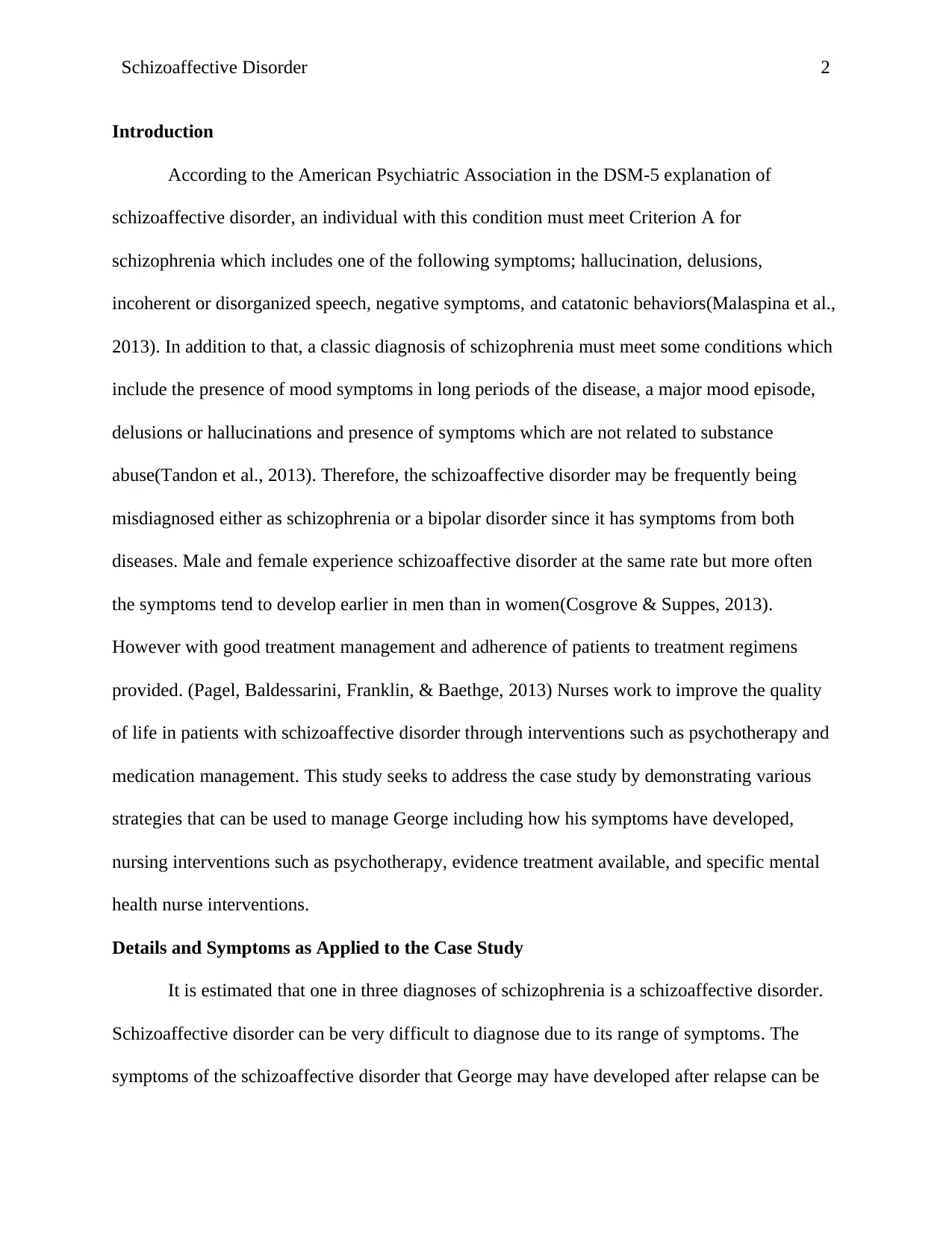
Schizoaffective Disorder 2
Introduction
According to the American Psychiatric Association in the DSM-5 explanation of
schizoaffective disorder, an individual with this condition must meet Criterion A for
schizophrenia which includes one of the following symptoms; hallucination, delusions,
incoherent or disorganized speech, negative symptoms, and catatonic behaviors(Malaspina et al.,
2013). In addition to that, a classic diagnosis of schizophrenia must meet some conditions which
include the presence of mood symptoms in long periods of the disease, a major mood episode,
delusions or hallucinations and presence of symptoms which are not related to substance
abuse(Tandon et al., 2013). Therefore, the schizoaffective disorder may be frequently being
misdiagnosed either as schizophrenia or a bipolar disorder since it has symptoms from both
diseases. Male and female experience schizoaffective disorder at the same rate but more often
the symptoms tend to develop earlier in men than in women(Cosgrove & Suppes, 2013).
However with good treatment management and adherence of patients to treatment regimens
provided. (Pagel, Baldessarini, Franklin, & Baethge, 2013) Nurses work to improve the quality
of life in patients with schizoaffective disorder through interventions such as psychotherapy and
medication management. This study seeks to address the case study by demonstrating various
strategies that can be used to manage George including how his symptoms have developed,
nursing interventions such as psychotherapy, evidence treatment available, and specific mental
health nurse interventions.
Details and Symptoms as Applied to the Case Study
It is estimated that one in three diagnoses of schizophrenia is a schizoaffective disorder.
Schizoaffective disorder can be very difficult to diagnose due to its range of symptoms. The
symptoms of the schizoaffective disorder that George may have developed after relapse can be
Introduction
According to the American Psychiatric Association in the DSM-5 explanation of
schizoaffective disorder, an individual with this condition must meet Criterion A for
schizophrenia which includes one of the following symptoms; hallucination, delusions,
incoherent or disorganized speech, negative symptoms, and catatonic behaviors(Malaspina et al.,
2013). In addition to that, a classic diagnosis of schizophrenia must meet some conditions which
include the presence of mood symptoms in long periods of the disease, a major mood episode,
delusions or hallucinations and presence of symptoms which are not related to substance
abuse(Tandon et al., 2013). Therefore, the schizoaffective disorder may be frequently being
misdiagnosed either as schizophrenia or a bipolar disorder since it has symptoms from both
diseases. Male and female experience schizoaffective disorder at the same rate but more often
the symptoms tend to develop earlier in men than in women(Cosgrove & Suppes, 2013).
However with good treatment management and adherence of patients to treatment regimens
provided. (Pagel, Baldessarini, Franklin, & Baethge, 2013) Nurses work to improve the quality
of life in patients with schizoaffective disorder through interventions such as psychotherapy and
medication management. This study seeks to address the case study by demonstrating various
strategies that can be used to manage George including how his symptoms have developed,
nursing interventions such as psychotherapy, evidence treatment available, and specific mental
health nurse interventions.
Details and Symptoms as Applied to the Case Study
It is estimated that one in three diagnoses of schizophrenia is a schizoaffective disorder.
Schizoaffective disorder can be very difficult to diagnose due to its range of symptoms. The
symptoms of the schizoaffective disorder that George may have developed after relapse can be
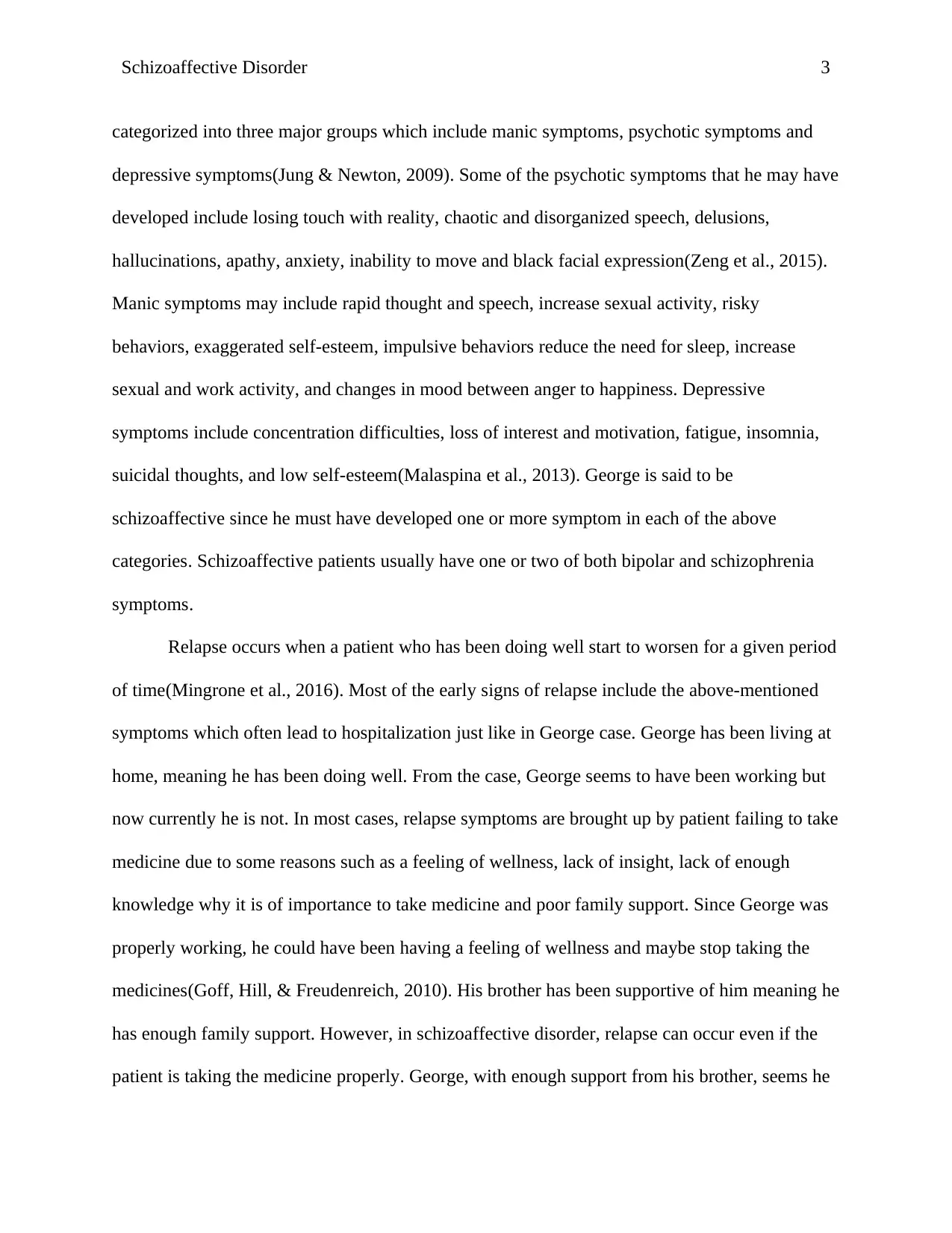
Schizoaffective Disorder 3
categorized into three major groups which include manic symptoms, psychotic symptoms and
depressive symptoms(Jung & Newton, 2009). Some of the psychotic symptoms that he may have
developed include losing touch with reality, chaotic and disorganized speech, delusions,
hallucinations, apathy, anxiety, inability to move and black facial expression(Zeng et al., 2015).
Manic symptoms may include rapid thought and speech, increase sexual activity, risky
behaviors, exaggerated self-esteem, impulsive behaviors reduce the need for sleep, increase
sexual and work activity, and changes in mood between anger to happiness. Depressive
symptoms include concentration difficulties, loss of interest and motivation, fatigue, insomnia,
suicidal thoughts, and low self-esteem(Malaspina et al., 2013). George is said to be
schizoaffective since he must have developed one or more symptom in each of the above
categories. Schizoaffective patients usually have one or two of both bipolar and schizophrenia
symptoms.
Relapse occurs when a patient who has been doing well start to worsen for a given period
of time(Mingrone et al., 2016). Most of the early signs of relapse include the above-mentioned
symptoms which often lead to hospitalization just like in George case. George has been living at
home, meaning he has been doing well. From the case, George seems to have been working but
now currently he is not. In most cases, relapse symptoms are brought up by patient failing to take
medicine due to some reasons such as a feeling of wellness, lack of insight, lack of enough
knowledge why it is of importance to take medicine and poor family support. Since George was
properly working, he could have been having a feeling of wellness and maybe stop taking the
medicines(Goff, Hill, & Freudenreich, 2010). His brother has been supportive of him meaning he
has enough family support. However, in schizoaffective disorder, relapse can occur even if the
patient is taking the medicine properly. George, with enough support from his brother, seems he
categorized into three major groups which include manic symptoms, psychotic symptoms and
depressive symptoms(Jung & Newton, 2009). Some of the psychotic symptoms that he may have
developed include losing touch with reality, chaotic and disorganized speech, delusions,
hallucinations, apathy, anxiety, inability to move and black facial expression(Zeng et al., 2015).
Manic symptoms may include rapid thought and speech, increase sexual activity, risky
behaviors, exaggerated self-esteem, impulsive behaviors reduce the need for sleep, increase
sexual and work activity, and changes in mood between anger to happiness. Depressive
symptoms include concentration difficulties, loss of interest and motivation, fatigue, insomnia,
suicidal thoughts, and low self-esteem(Malaspina et al., 2013). George is said to be
schizoaffective since he must have developed one or more symptom in each of the above
categories. Schizoaffective patients usually have one or two of both bipolar and schizophrenia
symptoms.
Relapse occurs when a patient who has been doing well start to worsen for a given period
of time(Mingrone et al., 2016). Most of the early signs of relapse include the above-mentioned
symptoms which often lead to hospitalization just like in George case. George has been living at
home, meaning he has been doing well. From the case, George seems to have been working but
now currently he is not. In most cases, relapse symptoms are brought up by patient failing to take
medicine due to some reasons such as a feeling of wellness, lack of insight, lack of enough
knowledge why it is of importance to take medicine and poor family support. Since George was
properly working, he could have been having a feeling of wellness and maybe stop taking the
medicines(Goff, Hill, & Freudenreich, 2010). His brother has been supportive of him meaning he
has enough family support. However, in schizoaffective disorder, relapse can occur even if the
patient is taking the medicine properly. George, with enough support from his brother, seems he

Schizoaffective Disorder 4
could have been taking his medicine as needed. Evidence shows that, despite adherence to
treatment, patients who have a long duration of illness have high chances of relapse(Tandon et
al., 2013). Increasing in chronicity of a condition has higher chances of relapse in the future
despite having certain knowledge about the importance of taking medications and
adherence(Mingrone et al., 2016). In addition to that, George has a history of sex abuse. Sex
abuse can impose all stress factors to an individual over a period o time leading to depression
and psych disorders that may lead to relapse even in schizoaffective disorder.
Psychopathology
The Exact pathophysiology of schizoaffective disorder is not well known but it is
suspected to involve neurotransmitter imbalances in the brain. Taking, for instance, George must
be having the abnormalities in neurotransmitters which include dopamine, norepinephrine, and
serotonin which could be contributing to his disorder(Malaspina et al., 2013). Thalamic
abnormalities reduced hippocampal volumes, and white matter abnormalities have been seen in
individuals with schizoaffective disorder. However, the major causes of the disease are still
unknown(Tandon et al., 2013). Scientists suggest that the schizoaffective disease can be like that
of schizophrenia but until to date, no specific genetic markers have been identified. Exposure to
the virus, birth complications, malnutrition may contribute to the development of a disease.
could have been taking his medicine as needed. Evidence shows that, despite adherence to
treatment, patients who have a long duration of illness have high chances of relapse(Tandon et
al., 2013). Increasing in chronicity of a condition has higher chances of relapse in the future
despite having certain knowledge about the importance of taking medications and
adherence(Mingrone et al., 2016). In addition to that, George has a history of sex abuse. Sex
abuse can impose all stress factors to an individual over a period o time leading to depression
and psych disorders that may lead to relapse even in schizoaffective disorder.
Psychopathology
The Exact pathophysiology of schizoaffective disorder is not well known but it is
suspected to involve neurotransmitter imbalances in the brain. Taking, for instance, George must
be having the abnormalities in neurotransmitters which include dopamine, norepinephrine, and
serotonin which could be contributing to his disorder(Malaspina et al., 2013). Thalamic
abnormalities reduced hippocampal volumes, and white matter abnormalities have been seen in
individuals with schizoaffective disorder. However, the major causes of the disease are still
unknown(Tandon et al., 2013). Scientists suggest that the schizoaffective disease can be like that
of schizophrenia but until to date, no specific genetic markers have been identified. Exposure to
the virus, birth complications, malnutrition may contribute to the development of a disease.
Secure Best Marks with AI Grader
Need help grading? Try our AI Grader for instant feedback on your assignments.
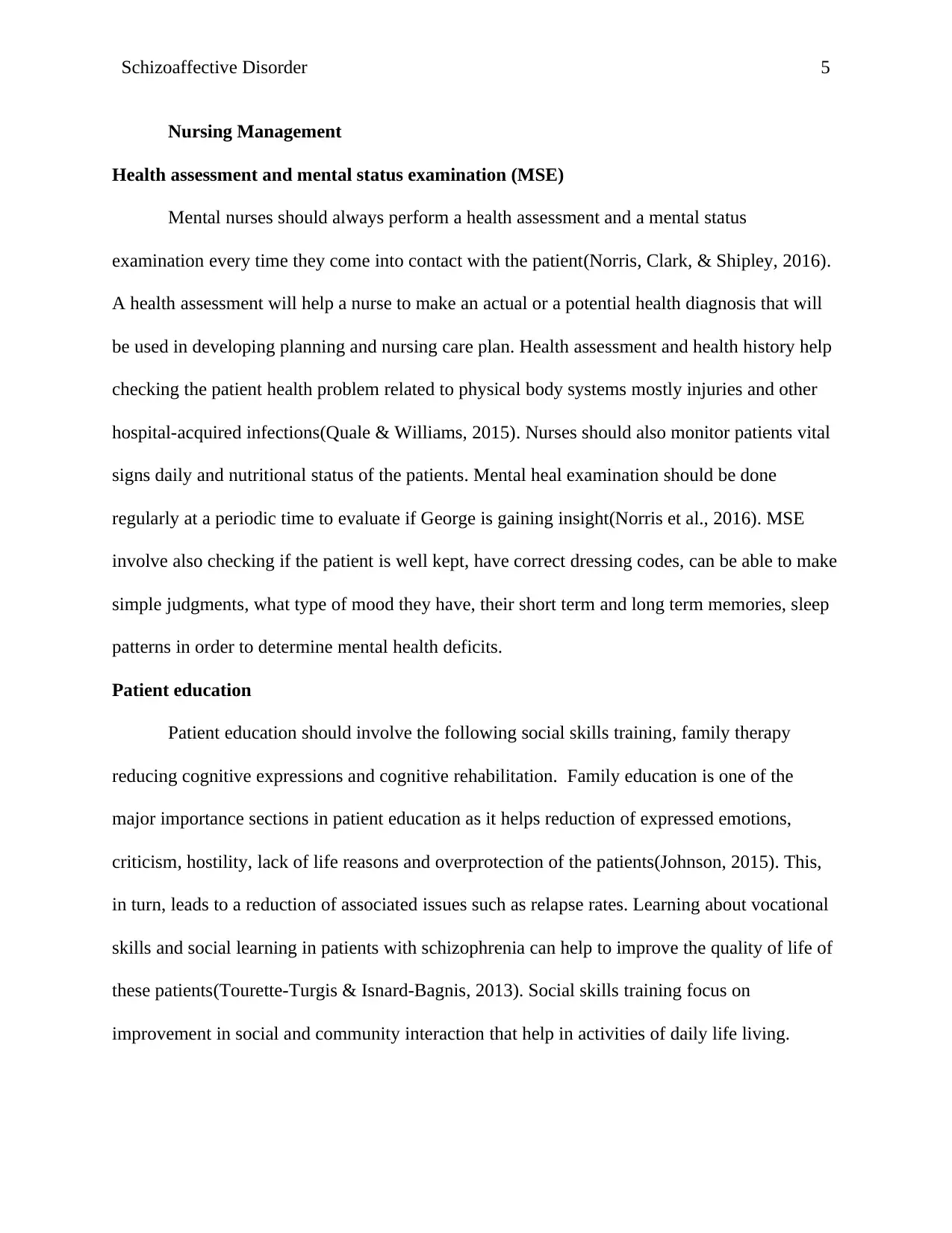
Schizoaffective Disorder 5
Nursing Management
Health assessment and mental status examination (MSE)
Mental nurses should always perform a health assessment and a mental status
examination every time they come into contact with the patient(Norris, Clark, & Shipley, 2016).
A health assessment will help a nurse to make an actual or a potential health diagnosis that will
be used in developing planning and nursing care plan. Health assessment and health history help
checking the patient health problem related to physical body systems mostly injuries and other
hospital-acquired infections(Quale & Williams, 2015). Nurses should also monitor patients vital
signs daily and nutritional status of the patients. Mental heal examination should be done
regularly at a periodic time to evaluate if George is gaining insight(Norris et al., 2016). MSE
involve also checking if the patient is well kept, have correct dressing codes, can be able to make
simple judgments, what type of mood they have, their short term and long term memories, sleep
patterns in order to determine mental health deficits.
Patient education
Patient education should involve the following social skills training, family therapy
reducing cognitive expressions and cognitive rehabilitation. Family education is one of the
major importance sections in patient education as it helps reduction of expressed emotions,
criticism, hostility, lack of life reasons and overprotection of the patients(Johnson, 2015). This,
in turn, leads to a reduction of associated issues such as relapse rates. Learning about vocational
skills and social learning in patients with schizophrenia can help to improve the quality of life of
these patients(Tourette-Turgis & Isnard-Bagnis, 2013). Social skills training focus on
improvement in social and community interaction that help in activities of daily life living.
Nursing Management
Health assessment and mental status examination (MSE)
Mental nurses should always perform a health assessment and a mental status
examination every time they come into contact with the patient(Norris, Clark, & Shipley, 2016).
A health assessment will help a nurse to make an actual or a potential health diagnosis that will
be used in developing planning and nursing care plan. Health assessment and health history help
checking the patient health problem related to physical body systems mostly injuries and other
hospital-acquired infections(Quale & Williams, 2015). Nurses should also monitor patients vital
signs daily and nutritional status of the patients. Mental heal examination should be done
regularly at a periodic time to evaluate if George is gaining insight(Norris et al., 2016). MSE
involve also checking if the patient is well kept, have correct dressing codes, can be able to make
simple judgments, what type of mood they have, their short term and long term memories, sleep
patterns in order to determine mental health deficits.
Patient education
Patient education should involve the following social skills training, family therapy
reducing cognitive expressions and cognitive rehabilitation. Family education is one of the
major importance sections in patient education as it helps reduction of expressed emotions,
criticism, hostility, lack of life reasons and overprotection of the patients(Johnson, 2015). This,
in turn, leads to a reduction of associated issues such as relapse rates. Learning about vocational
skills and social learning in patients with schizophrenia can help to improve the quality of life of
these patients(Tourette-Turgis & Isnard-Bagnis, 2013). Social skills training focus on
improvement in social and community interaction that help in activities of daily life living.
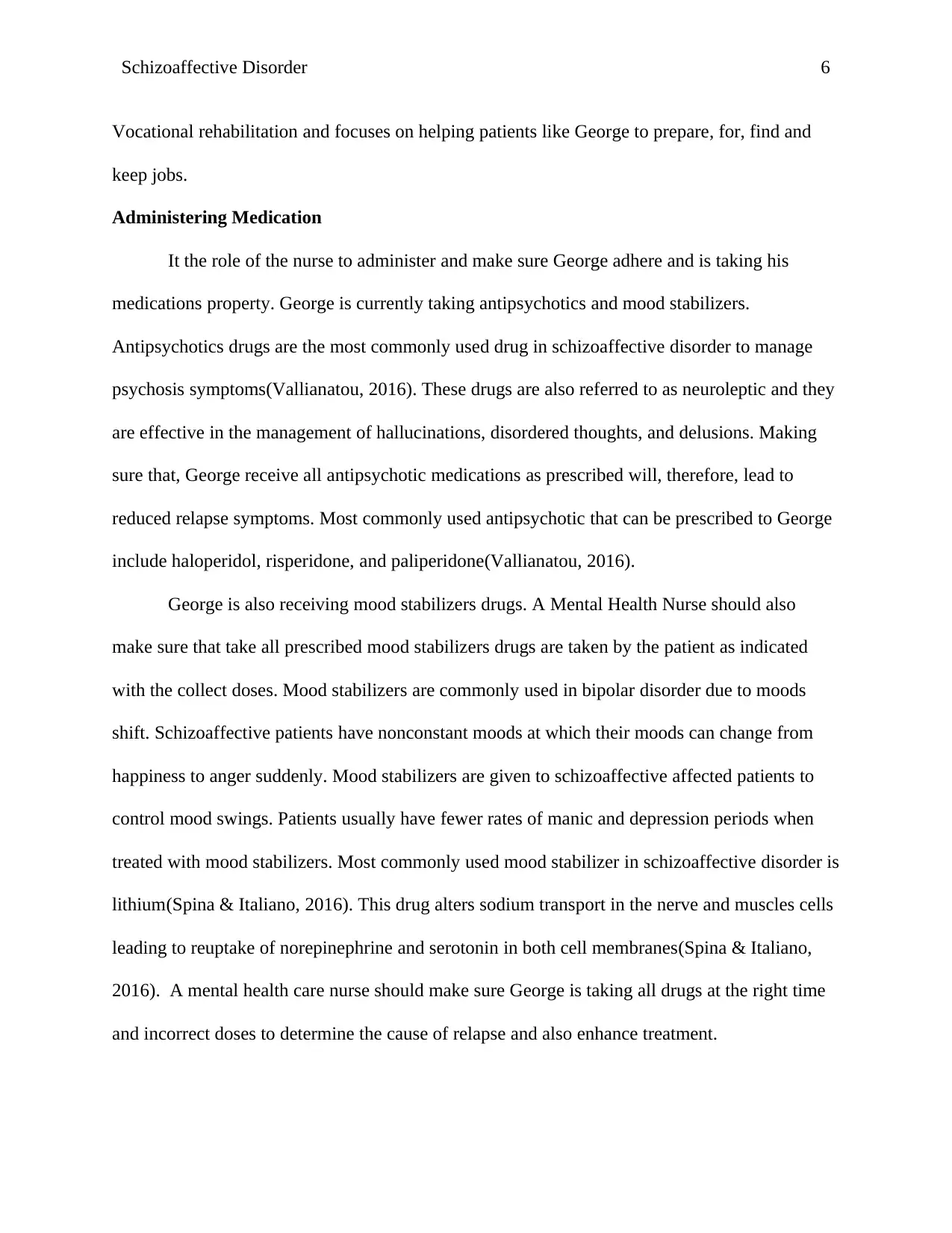
Schizoaffective Disorder 6
Vocational rehabilitation and focuses on helping patients like George to prepare, for, find and
keep jobs.
Administering Medication
It the role of the nurse to administer and make sure George adhere and is taking his
medications property. George is currently taking antipsychotics and mood stabilizers.
Antipsychotics drugs are the most commonly used drug in schizoaffective disorder to manage
psychosis symptoms(Vallianatou, 2016). These drugs are also referred to as neuroleptic and they
are effective in the management of hallucinations, disordered thoughts, and delusions. Making
sure that, George receive all antipsychotic medications as prescribed will, therefore, lead to
reduced relapse symptoms. Most commonly used antipsychotic that can be prescribed to George
include haloperidol, risperidone, and paliperidone(Vallianatou, 2016).
George is also receiving mood stabilizers drugs. A Mental Health Nurse should also
make sure that take all prescribed mood stabilizers drugs are taken by the patient as indicated
with the collect doses. Mood stabilizers are commonly used in bipolar disorder due to moods
shift. Schizoaffective patients have nonconstant moods at which their moods can change from
happiness to anger suddenly. Mood stabilizers are given to schizoaffective affected patients to
control mood swings. Patients usually have fewer rates of manic and depression periods when
treated with mood stabilizers. Most commonly used mood stabilizer in schizoaffective disorder is
lithium(Spina & Italiano, 2016). This drug alters sodium transport in the nerve and muscles cells
leading to reuptake of norepinephrine and serotonin in both cell membranes(Spina & Italiano,
2016). A mental health care nurse should make sure George is taking all drugs at the right time
and incorrect doses to determine the cause of relapse and also enhance treatment.
Vocational rehabilitation and focuses on helping patients like George to prepare, for, find and
keep jobs.
Administering Medication
It the role of the nurse to administer and make sure George adhere and is taking his
medications property. George is currently taking antipsychotics and mood stabilizers.
Antipsychotics drugs are the most commonly used drug in schizoaffective disorder to manage
psychosis symptoms(Vallianatou, 2016). These drugs are also referred to as neuroleptic and they
are effective in the management of hallucinations, disordered thoughts, and delusions. Making
sure that, George receive all antipsychotic medications as prescribed will, therefore, lead to
reduced relapse symptoms. Most commonly used antipsychotic that can be prescribed to George
include haloperidol, risperidone, and paliperidone(Vallianatou, 2016).
George is also receiving mood stabilizers drugs. A Mental Health Nurse should also
make sure that take all prescribed mood stabilizers drugs are taken by the patient as indicated
with the collect doses. Mood stabilizers are commonly used in bipolar disorder due to moods
shift. Schizoaffective patients have nonconstant moods at which their moods can change from
happiness to anger suddenly. Mood stabilizers are given to schizoaffective affected patients to
control mood swings. Patients usually have fewer rates of manic and depression periods when
treated with mood stabilizers. Most commonly used mood stabilizer in schizoaffective disorder is
lithium(Spina & Italiano, 2016). This drug alters sodium transport in the nerve and muscles cells
leading to reuptake of norepinephrine and serotonin in both cell membranes(Spina & Italiano,
2016). A mental health care nurse should make sure George is taking all drugs at the right time
and incorrect doses to determine the cause of relapse and also enhance treatment.

Schizoaffective Disorder 7
Assisting in daily living activities
Mentally ill patient has imbalance thought process and thus they may not make good
decisions on what they should or not at a given time. It is the responsibility of a mental health
nurse should make sure he or she assist George to conduct activities of daily living like washing,
teeth brushing, changing into clean clothes, rest and sleeping, and doing exercises like walking
dancing where possible(Liu, Unick, Galik, & Resnick, 2015). Other than that, nurses should
make sure patients are feeding well and eliminating to allow absorption of new nutrient and
removal of the waste products.
Conducting and helping in psychotherapy
The nurse should offer George with Cognitive Behavioral Therapy (CBT) as supportive
psychotherapy or counseling in order to help with psychotic symptoms(Kingdon & Mander,
2015). CBT helps the patient to understand links between feelings thought and actions, enable
one to gain insight into one's health, symptoms and how that affect his life and make perceptions
concerning beliefs and reasoning. The major aims of conducting a CBT to George may include
helping him to be aware that his thoughts, behaviors, and feelings are changing, giving a way of
coping with his symptoms, and reducing stress and function improvement(Hagen & Hjemdal,
2012).
Conducting Family Therapy with George and his Brother
Not all patients want their families to be introduced in their individual care. However,
since George’s brother cares about him and lives together conducting family therapy on how the
care should be included is of importance. George’s brother is his primary source of long social
support and thus he might need to know if he can help to reduce and promote care. Other than
that, he can be very good important information that will help in the management of George.
Assisting in daily living activities
Mentally ill patient has imbalance thought process and thus they may not make good
decisions on what they should or not at a given time. It is the responsibility of a mental health
nurse should make sure he or she assist George to conduct activities of daily living like washing,
teeth brushing, changing into clean clothes, rest and sleeping, and doing exercises like walking
dancing where possible(Liu, Unick, Galik, & Resnick, 2015). Other than that, nurses should
make sure patients are feeding well and eliminating to allow absorption of new nutrient and
removal of the waste products.
Conducting and helping in psychotherapy
The nurse should offer George with Cognitive Behavioral Therapy (CBT) as supportive
psychotherapy or counseling in order to help with psychotic symptoms(Kingdon & Mander,
2015). CBT helps the patient to understand links between feelings thought and actions, enable
one to gain insight into one's health, symptoms and how that affect his life and make perceptions
concerning beliefs and reasoning. The major aims of conducting a CBT to George may include
helping him to be aware that his thoughts, behaviors, and feelings are changing, giving a way of
coping with his symptoms, and reducing stress and function improvement(Hagen & Hjemdal,
2012).
Conducting Family Therapy with George and his Brother
Not all patients want their families to be introduced in their individual care. However,
since George’s brother cares about him and lives together conducting family therapy on how the
care should be included is of importance. George’s brother is his primary source of long social
support and thus he might need to know if he can help to reduce and promote care. Other than
that, he can be very good important information that will help in the management of George.
Paraphrase This Document
Need a fresh take? Get an instant paraphrase of this document with our AI Paraphraser
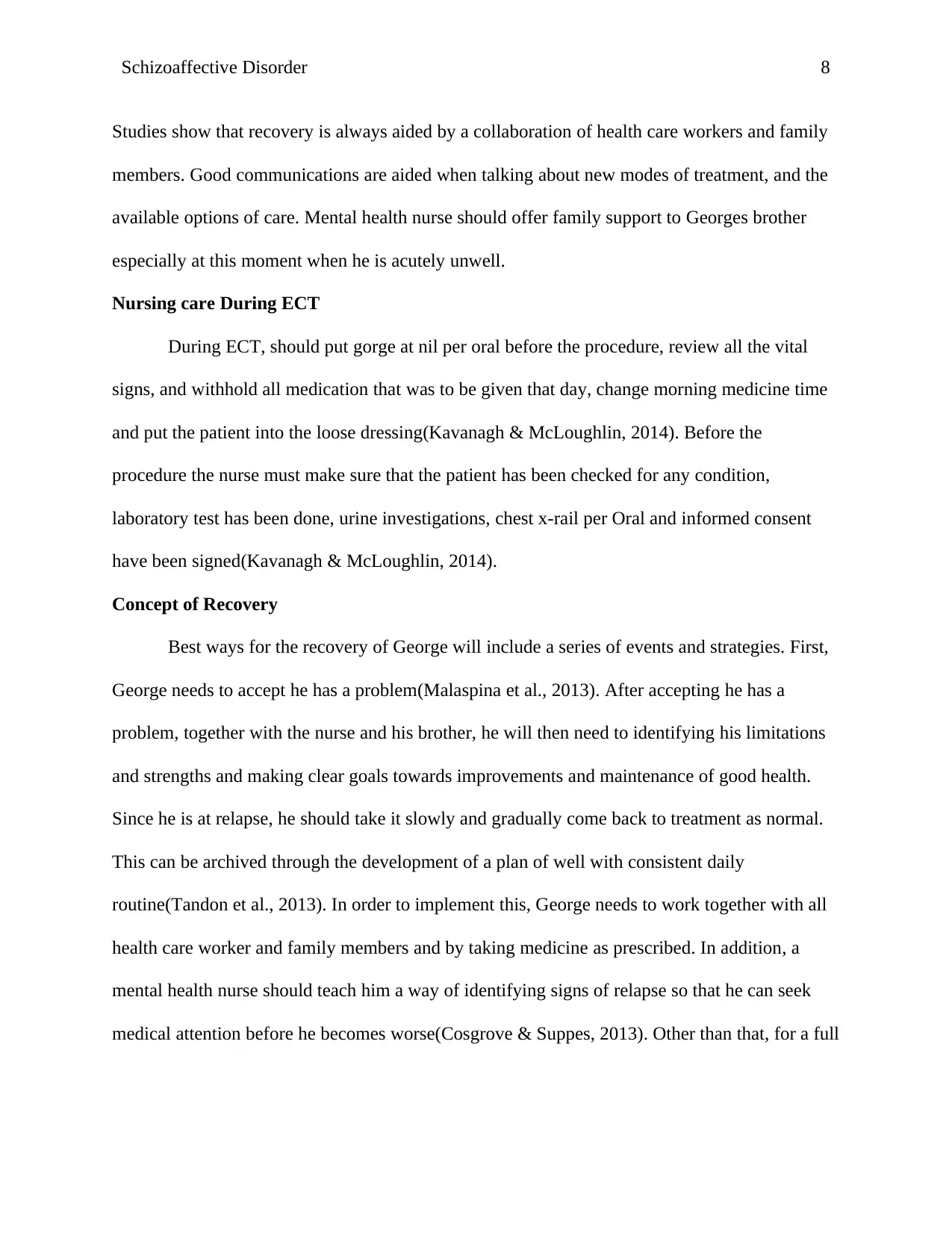
Schizoaffective Disorder 8
Studies show that recovery is always aided by a collaboration of health care workers and family
members. Good communications are aided when talking about new modes of treatment, and the
available options of care. Mental health nurse should offer family support to Georges brother
especially at this moment when he is acutely unwell.
Nursing care During ECT
During ECT, should put gorge at nil per oral before the procedure, review all the vital
signs, and withhold all medication that was to be given that day, change morning medicine time
and put the patient into the loose dressing(Kavanagh & McLoughlin, 2014). Before the
procedure the nurse must make sure that the patient has been checked for any condition,
laboratory test has been done, urine investigations, chest x-rail per Oral and informed consent
have been signed(Kavanagh & McLoughlin, 2014).
Concept of Recovery
Best ways for the recovery of George will include a series of events and strategies. First,
George needs to accept he has a problem(Malaspina et al., 2013). After accepting he has a
problem, together with the nurse and his brother, he will then need to identifying his limitations
and strengths and making clear goals towards improvements and maintenance of good health.
Since he is at relapse, he should take it slowly and gradually come back to treatment as normal.
This can be archived through the development of a plan of well with consistent daily
routine(Tandon et al., 2013). In order to implement this, George needs to work together with all
health care worker and family members and by taking medicine as prescribed. In addition, a
mental health nurse should teach him a way of identifying signs of relapse so that he can seek
medical attention before he becomes worse(Cosgrove & Suppes, 2013). Other than that, for a full
Studies show that recovery is always aided by a collaboration of health care workers and family
members. Good communications are aided when talking about new modes of treatment, and the
available options of care. Mental health nurse should offer family support to Georges brother
especially at this moment when he is acutely unwell.
Nursing care During ECT
During ECT, should put gorge at nil per oral before the procedure, review all the vital
signs, and withhold all medication that was to be given that day, change morning medicine time
and put the patient into the loose dressing(Kavanagh & McLoughlin, 2014). Before the
procedure the nurse must make sure that the patient has been checked for any condition,
laboratory test has been done, urine investigations, chest x-rail per Oral and informed consent
have been signed(Kavanagh & McLoughlin, 2014).
Concept of Recovery
Best ways for the recovery of George will include a series of events and strategies. First,
George needs to accept he has a problem(Malaspina et al., 2013). After accepting he has a
problem, together with the nurse and his brother, he will then need to identifying his limitations
and strengths and making clear goals towards improvements and maintenance of good health.
Since he is at relapse, he should take it slowly and gradually come back to treatment as normal.
This can be archived through the development of a plan of well with consistent daily
routine(Tandon et al., 2013). In order to implement this, George needs to work together with all
health care worker and family members and by taking medicine as prescribed. In addition, a
mental health nurse should teach him a way of identifying signs of relapse so that he can seek
medical attention before he becomes worse(Cosgrove & Suppes, 2013). Other than that, for a full
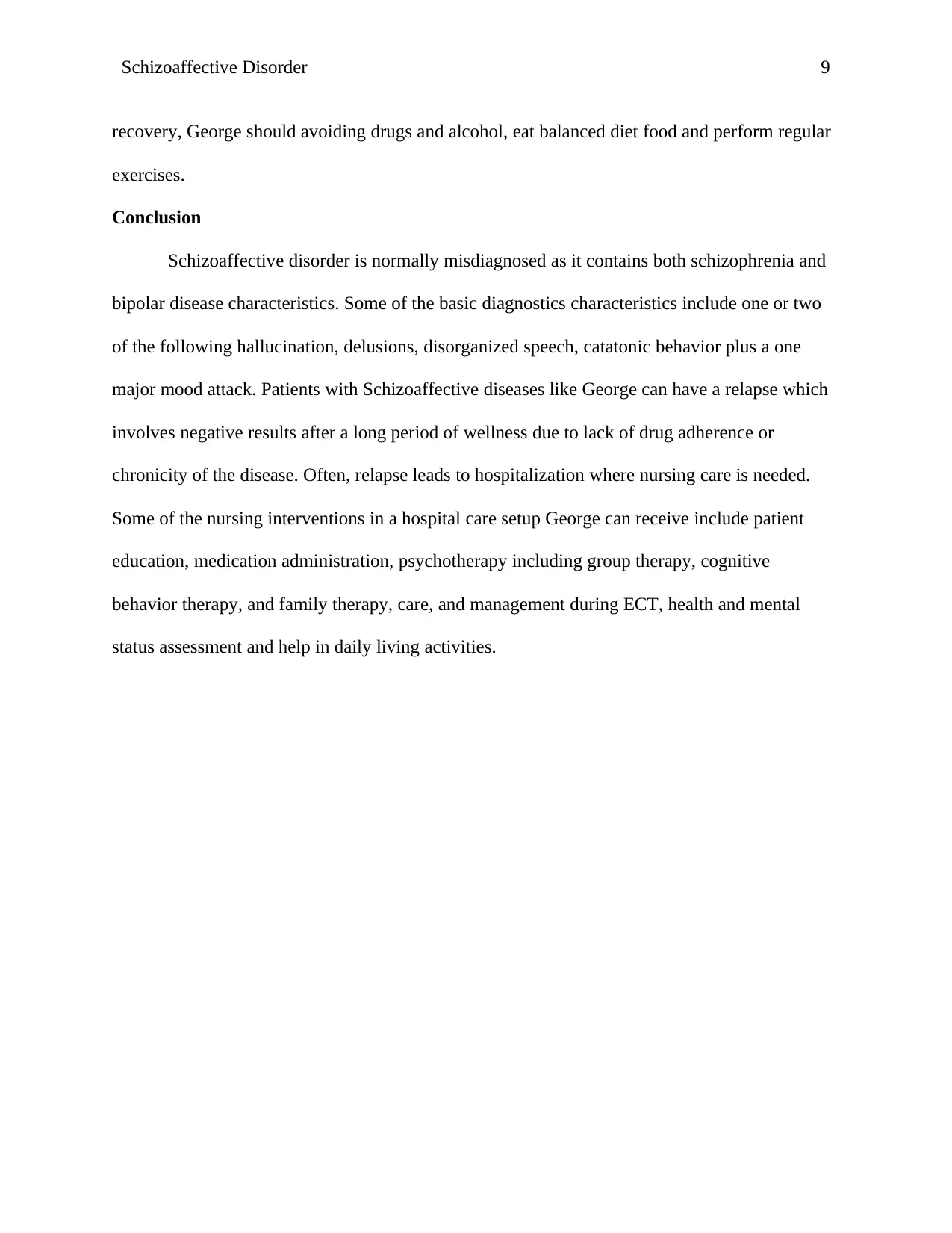
Schizoaffective Disorder 9
recovery, George should avoiding drugs and alcohol, eat balanced diet food and perform regular
exercises.
Conclusion
Schizoaffective disorder is normally misdiagnosed as it contains both schizophrenia and
bipolar disease characteristics. Some of the basic diagnostics characteristics include one or two
of the following hallucination, delusions, disorganized speech, catatonic behavior plus a one
major mood attack. Patients with Schizoaffective diseases like George can have a relapse which
involves negative results after a long period of wellness due to lack of drug adherence or
chronicity of the disease. Often, relapse leads to hospitalization where nursing care is needed.
Some of the nursing interventions in a hospital care setup George can receive include patient
education, medication administration, psychotherapy including group therapy, cognitive
behavior therapy, and family therapy, care, and management during ECT, health and mental
status assessment and help in daily living activities.
recovery, George should avoiding drugs and alcohol, eat balanced diet food and perform regular
exercises.
Conclusion
Schizoaffective disorder is normally misdiagnosed as it contains both schizophrenia and
bipolar disease characteristics. Some of the basic diagnostics characteristics include one or two
of the following hallucination, delusions, disorganized speech, catatonic behavior plus a one
major mood attack. Patients with Schizoaffective diseases like George can have a relapse which
involves negative results after a long period of wellness due to lack of drug adherence or
chronicity of the disease. Often, relapse leads to hospitalization where nursing care is needed.
Some of the nursing interventions in a hospital care setup George can receive include patient
education, medication administration, psychotherapy including group therapy, cognitive
behavior therapy, and family therapy, care, and management during ECT, health and mental
status assessment and help in daily living activities.
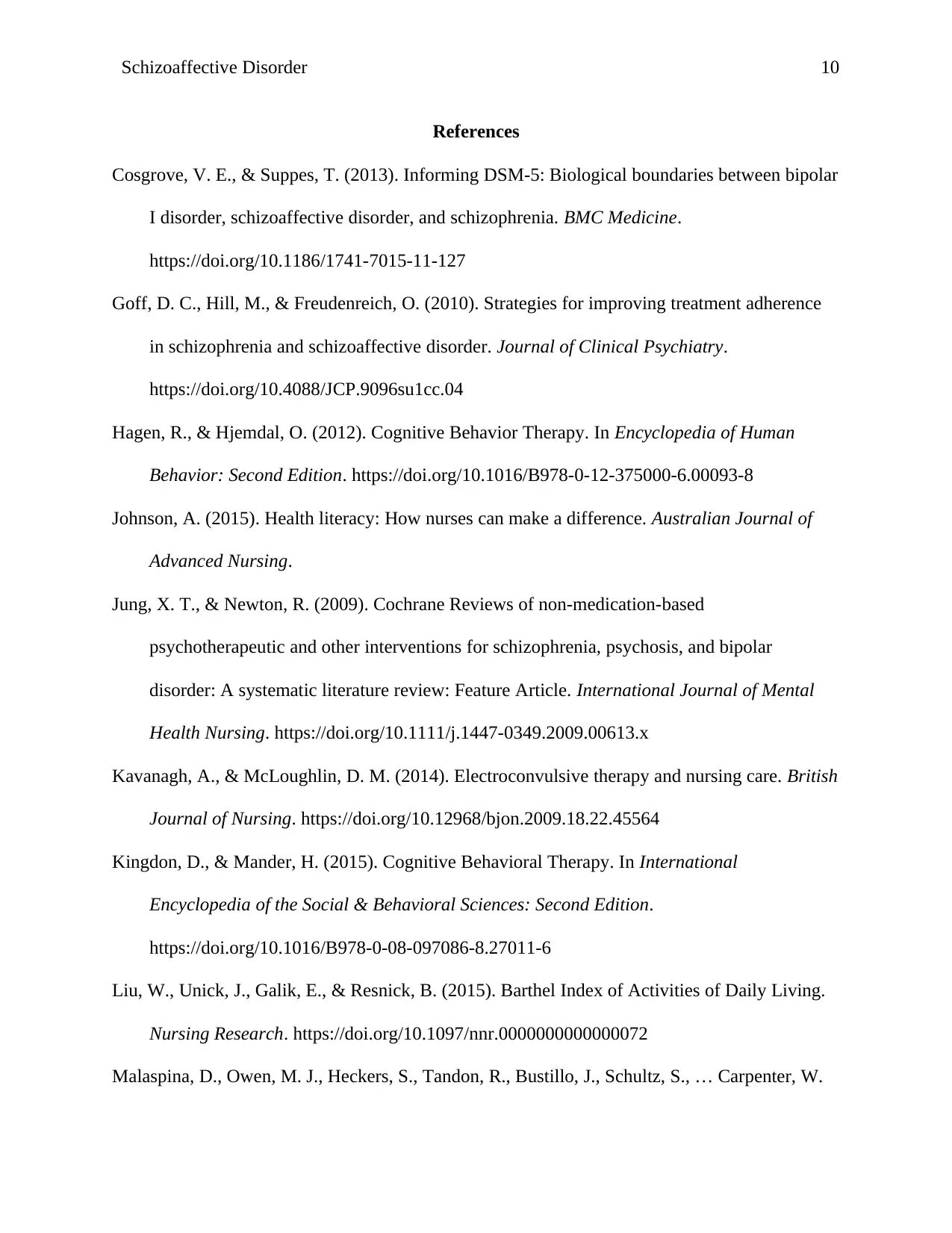
Schizoaffective Disorder 10
References
Cosgrove, V. E., & Suppes, T. (2013). Informing DSM-5: Biological boundaries between bipolar
I disorder, schizoaffective disorder, and schizophrenia. BMC Medicine.
https://doi.org/10.1186/1741-7015-11-127
Goff, D. C., Hill, M., & Freudenreich, O. (2010). Strategies for improving treatment adherence
in schizophrenia and schizoaffective disorder. Journal of Clinical Psychiatry.
https://doi.org/10.4088/JCP.9096su1cc.04
Hagen, R., & Hjemdal, O. (2012). Cognitive Behavior Therapy. In Encyclopedia of Human
Behavior: Second Edition. https://doi.org/10.1016/B978-0-12-375000-6.00093-8
Johnson, A. (2015). Health literacy: How nurses can make a difference. Australian Journal of
Advanced Nursing.
Jung, X. T., & Newton, R. (2009). Cochrane Reviews of non-medication-based
psychotherapeutic and other interventions for schizophrenia, psychosis, and bipolar
disorder: A systematic literature review: Feature Article. International Journal of Mental
Health Nursing. https://doi.org/10.1111/j.1447-0349.2009.00613.x
Kavanagh, A., & McLoughlin, D. M. (2014). Electroconvulsive therapy and nursing care. British
Journal of Nursing. https://doi.org/10.12968/bjon.2009.18.22.45564
Kingdon, D., & Mander, H. (2015). Cognitive Behavioral Therapy. In International
Encyclopedia of the Social & Behavioral Sciences: Second Edition.
https://doi.org/10.1016/B978-0-08-097086-8.27011-6
Liu, W., Unick, J., Galik, E., & Resnick, B. (2015). Barthel Index of Activities of Daily Living.
Nursing Research. https://doi.org/10.1097/nnr.0000000000000072
Malaspina, D., Owen, M. J., Heckers, S., Tandon, R., Bustillo, J., Schultz, S., … Carpenter, W.
References
Cosgrove, V. E., & Suppes, T. (2013). Informing DSM-5: Biological boundaries between bipolar
I disorder, schizoaffective disorder, and schizophrenia. BMC Medicine.
https://doi.org/10.1186/1741-7015-11-127
Goff, D. C., Hill, M., & Freudenreich, O. (2010). Strategies for improving treatment adherence
in schizophrenia and schizoaffective disorder. Journal of Clinical Psychiatry.
https://doi.org/10.4088/JCP.9096su1cc.04
Hagen, R., & Hjemdal, O. (2012). Cognitive Behavior Therapy. In Encyclopedia of Human
Behavior: Second Edition. https://doi.org/10.1016/B978-0-12-375000-6.00093-8
Johnson, A. (2015). Health literacy: How nurses can make a difference. Australian Journal of
Advanced Nursing.
Jung, X. T., & Newton, R. (2009). Cochrane Reviews of non-medication-based
psychotherapeutic and other interventions for schizophrenia, psychosis, and bipolar
disorder: A systematic literature review: Feature Article. International Journal of Mental
Health Nursing. https://doi.org/10.1111/j.1447-0349.2009.00613.x
Kavanagh, A., & McLoughlin, D. M. (2014). Electroconvulsive therapy and nursing care. British
Journal of Nursing. https://doi.org/10.12968/bjon.2009.18.22.45564
Kingdon, D., & Mander, H. (2015). Cognitive Behavioral Therapy. In International
Encyclopedia of the Social & Behavioral Sciences: Second Edition.
https://doi.org/10.1016/B978-0-08-097086-8.27011-6
Liu, W., Unick, J., Galik, E., & Resnick, B. (2015). Barthel Index of Activities of Daily Living.
Nursing Research. https://doi.org/10.1097/nnr.0000000000000072
Malaspina, D., Owen, M. J., Heckers, S., Tandon, R., Bustillo, J., Schultz, S., … Carpenter, W.
Secure Best Marks with AI Grader
Need help grading? Try our AI Grader for instant feedback on your assignments.
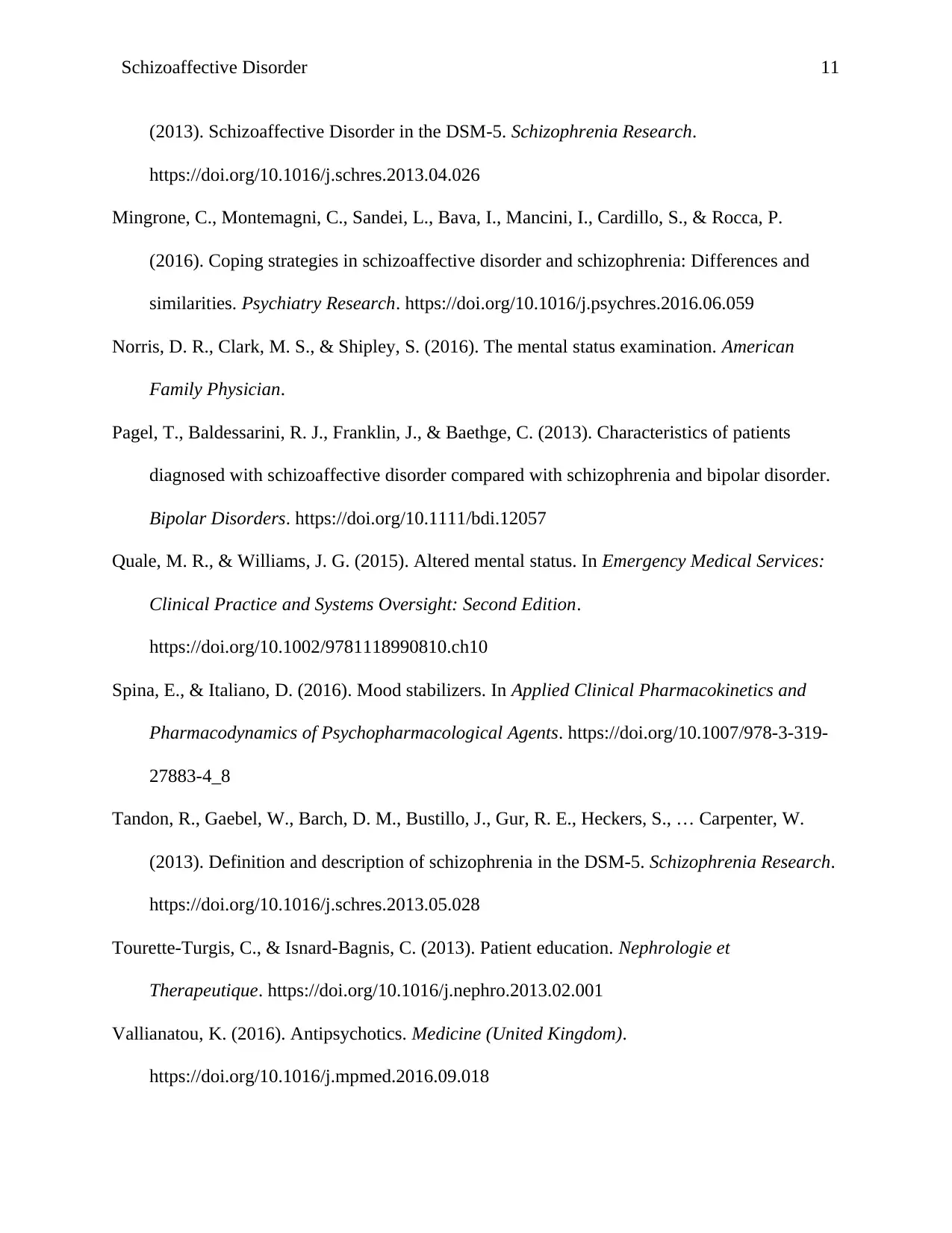
Schizoaffective Disorder 11
(2013). Schizoaffective Disorder in the DSM-5. Schizophrenia Research.
https://doi.org/10.1016/j.schres.2013.04.026
Mingrone, C., Montemagni, C., Sandei, L., Bava, I., Mancini, I., Cardillo, S., & Rocca, P.
(2016). Coping strategies in schizoaffective disorder and schizophrenia: Differences and
similarities. Psychiatry Research. https://doi.org/10.1016/j.psychres.2016.06.059
Norris, D. R., Clark, M. S., & Shipley, S. (2016). The mental status examination. American
Family Physician.
Pagel, T., Baldessarini, R. J., Franklin, J., & Baethge, C. (2013). Characteristics of patients
diagnosed with schizoaffective disorder compared with schizophrenia and bipolar disorder.
Bipolar Disorders. https://doi.org/10.1111/bdi.12057
Quale, M. R., & Williams, J. G. (2015). Altered mental status. In Emergency Medical Services:
Clinical Practice and Systems Oversight: Second Edition.
https://doi.org/10.1002/9781118990810.ch10
Spina, E., & Italiano, D. (2016). Mood stabilizers. In Applied Clinical Pharmacokinetics and
Pharmacodynamics of Psychopharmacological Agents. https://doi.org/10.1007/978-3-319-
27883-4_8
Tandon, R., Gaebel, W., Barch, D. M., Bustillo, J., Gur, R. E., Heckers, S., … Carpenter, W.
(2013). Definition and description of schizophrenia in the DSM-5. Schizophrenia Research.
https://doi.org/10.1016/j.schres.2013.05.028
Tourette-Turgis, C., & Isnard-Bagnis, C. (2013). Patient education. Nephrologie et
Therapeutique. https://doi.org/10.1016/j.nephro.2013.02.001
Vallianatou, K. (2016). Antipsychotics. Medicine (United Kingdom).
https://doi.org/10.1016/j.mpmed.2016.09.018
(2013). Schizoaffective Disorder in the DSM-5. Schizophrenia Research.
https://doi.org/10.1016/j.schres.2013.04.026
Mingrone, C., Montemagni, C., Sandei, L., Bava, I., Mancini, I., Cardillo, S., & Rocca, P.
(2016). Coping strategies in schizoaffective disorder and schizophrenia: Differences and
similarities. Psychiatry Research. https://doi.org/10.1016/j.psychres.2016.06.059
Norris, D. R., Clark, M. S., & Shipley, S. (2016). The mental status examination. American
Family Physician.
Pagel, T., Baldessarini, R. J., Franklin, J., & Baethge, C. (2013). Characteristics of patients
diagnosed with schizoaffective disorder compared with schizophrenia and bipolar disorder.
Bipolar Disorders. https://doi.org/10.1111/bdi.12057
Quale, M. R., & Williams, J. G. (2015). Altered mental status. In Emergency Medical Services:
Clinical Practice and Systems Oversight: Second Edition.
https://doi.org/10.1002/9781118990810.ch10
Spina, E., & Italiano, D. (2016). Mood stabilizers. In Applied Clinical Pharmacokinetics and
Pharmacodynamics of Psychopharmacological Agents. https://doi.org/10.1007/978-3-319-
27883-4_8
Tandon, R., Gaebel, W., Barch, D. M., Bustillo, J., Gur, R. E., Heckers, S., … Carpenter, W.
(2013). Definition and description of schizophrenia in the DSM-5. Schizophrenia Research.
https://doi.org/10.1016/j.schres.2013.05.028
Tourette-Turgis, C., & Isnard-Bagnis, C. (2013). Patient education. Nephrologie et
Therapeutique. https://doi.org/10.1016/j.nephro.2013.02.001
Vallianatou, K. (2016). Antipsychotics. Medicine (United Kingdom).
https://doi.org/10.1016/j.mpmed.2016.09.018
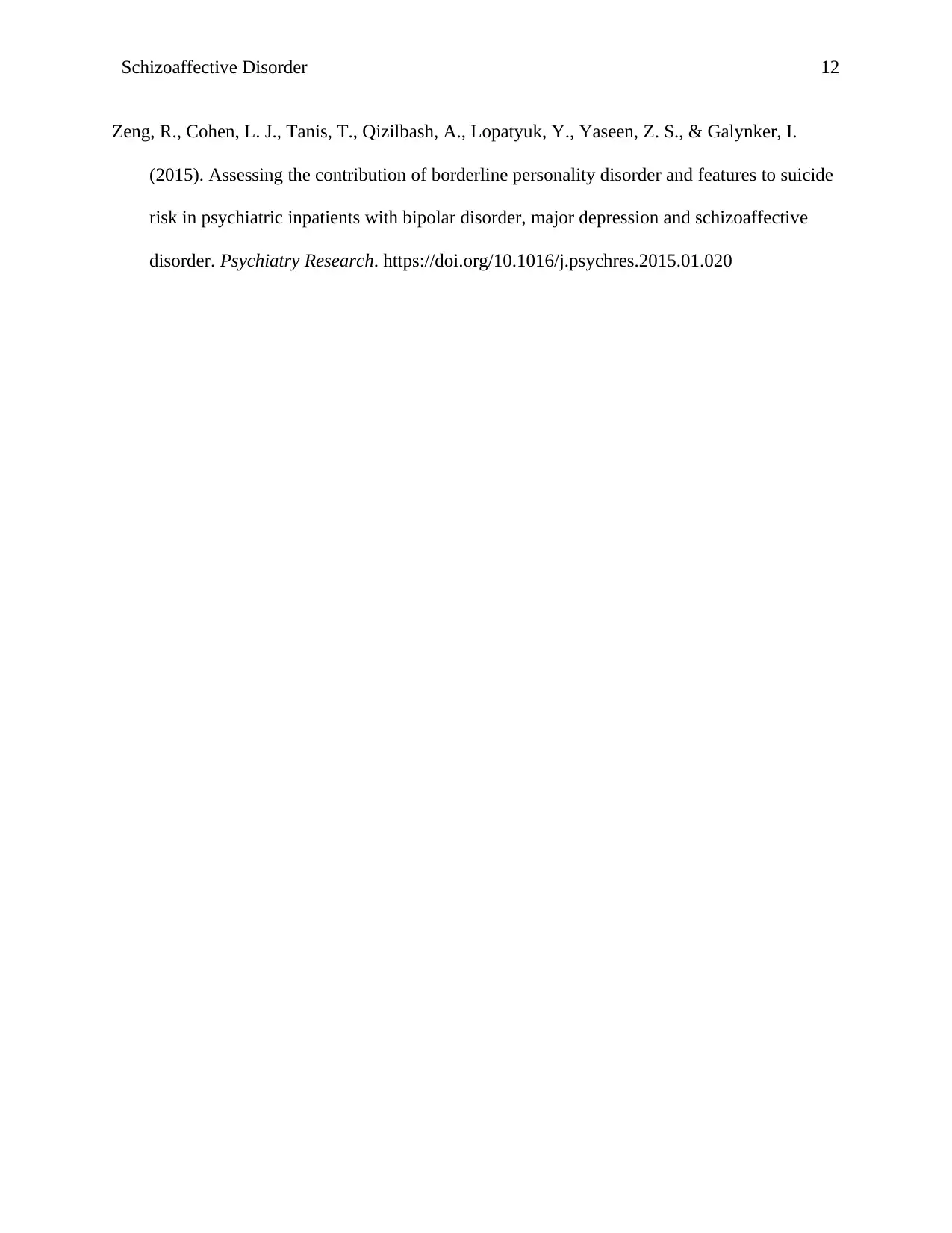
Schizoaffective Disorder 12
Zeng, R., Cohen, L. J., Tanis, T., Qizilbash, A., Lopatyuk, Y., Yaseen, Z. S., & Galynker, I.
(2015). Assessing the contribution of borderline personality disorder and features to suicide
risk in psychiatric inpatients with bipolar disorder, major depression and schizoaffective
disorder. Psychiatry Research. https://doi.org/10.1016/j.psychres.2015.01.020
Zeng, R., Cohen, L. J., Tanis, T., Qizilbash, A., Lopatyuk, Y., Yaseen, Z. S., & Galynker, I.
(2015). Assessing the contribution of borderline personality disorder and features to suicide
risk in psychiatric inpatients with bipolar disorder, major depression and schizoaffective
disorder. Psychiatry Research. https://doi.org/10.1016/j.psychres.2015.01.020
1 out of 12
Related Documents
Your All-in-One AI-Powered Toolkit for Academic Success.
+13062052269
info@desklib.com
Available 24*7 on WhatsApp / Email
![[object Object]](/_next/static/media/star-bottom.7253800d.svg)
Unlock your academic potential
© 2024 | Zucol Services PVT LTD | All rights reserved.





